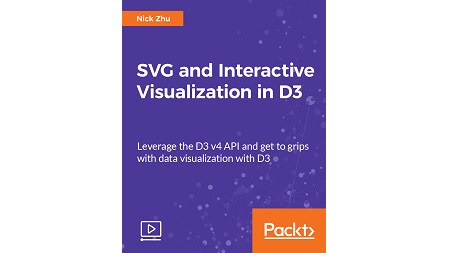
English | MP4 | AVC 1280×720 | AAC 44KHz 2ch | 1h 42m | 750 MB
Create breathtaking data visualizations using the latest features of D3
D3.js is a JavaScript library designed to display digital data in dynamic graphical form. It helps you bring data to life using HTML, SVG, and CSS. D3 allows greater control over the final visual result, and it is the hottest and most powerful web-based data visualization technology on the market today. In this course, you will learn how to map values in your data domain to the visual domain using scales, and use the various shape functions supported by D3 to create SVG shapes in visualizations. Moving on, you’ll see how to use and customize various D3 axes and master transition to add bells and whistles to otherwise dry visualizations.
This course is designed to provide you with all the guidance you need to get to grips with data visualization with D3. With this course, you will create breathtaking data visualization with professional efficiency and precision with the help of practical illustrations, and code samples.
What You Will Learn
- Learn about Scalable Vector Graphic (SVG), a mature World Wide Web Consortium (W3C) standard widely used in visualization projects
- Explore Charts and generate some of the most complex and interesting visualizations
- Add steering capability to your visualization
- Use force simulation to create awe-inspiring effects
- Implement a fully functional geographic visualization in D3
- Implement your visualization like a pro with Test-Driven Development (TDD)
Table of Contents
01 The Course Overview
02 What Is SVG
03 Creating Simple Shapes
04 Using a Line Generator
05 Using a Line Curve
06 Changing Line Tension
07 Using an Area Generator
08 Using Area Curve
09 Using an Arc Generator
10 Implementing Arc Transition
11 Creating a Line Chart
12 Creating an Area Chart
13 Creating a Scatter Plot Chart
14 Creating a Bubble Chart
15 Creating a Bar Chart
16 Building a Pie Chart
17 Building a Stacked Area Chart
18 Building a Treemap
19 Building a Tree
20 Building an Enclosure Diagram
21 Interacting with Mouse Events
22 Implementing Zoom and Pan Behavior
23 Implementing Drag Behavior
24 Using Gravity and Charge
25 Customizing Velocity
26 Setting the Link Constraint
27 Using Force to Assist Visualization
28 Building a Force-Directed Graph
29 Projecting the US Map
30 Projecting the World Map
31 Building a Choropleth Map
32 Getting Jasmine and Setting Up the Test Environment
33 Chart Creation, SVG Rendering,and Pixel-Perfect Bar Rendering
Resolve the captcha to access the links!